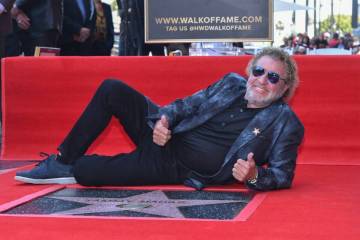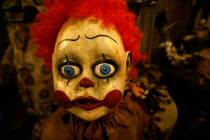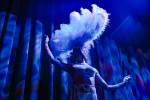UNLV pulls off a triple play of dance, drama, song
Three shows, two weekends, one campus, no waiting. ...
Maybe a few minutes idling in line if you're one of those last-minute-ticket types.
Either way, watch 'em dance it, act it and sing it at the University of Nevada, Las Vegas, which goes curtain-up on the musical revue "Defying Gravity: The Music of Stephen Schwartz" and the fleet-footed fantasia "Dancing on the Edge of a Dream" on Saturday, and the drama "The Chasm" through Feb. 8.
"The music is so glorious and so adored by the public, it's the perfect way to warm up a winter's night," says Gordon Greenberg, director of the Schwartz tribute, an entry in the New York Stage & Beyond series created specifically for UNLV. "We're using three of the best, hottest performers on Broadway."
They would be Julia Murney, David Burnham and Farah Alvin, interpreting the repertoire of the legendary Great White Way tunesmith behind "Wicked" (the title, "Defying Gravity," refers to a song from the "Wicked" score), "Pocahontas," "Godspell" and the enduring "Pippin," Schwartz's maiden show, which he composed while still a college kid.
"He has a knack for tapping into that part of our brain that makes the hairs on the back of your neck stand up," Greenberg says. "It's that visceral thrill. That's why 'Wicked' is the phenomenon it is. Pretty much everything he writes catches fire immediately, because he taps into a great humanity."
Though Schwartz's style, he says, is influenced by popular music from the '70s through today, Greenberg adds that "it adheres to the great tradition of musical storytelling like Rodgers and Hammerstein. It feels contemporary and vital and true, but it's very theatrical."
Still feelin' that New York vibe? Hop a downtown subway toward the Lower East Side for "Dancing on the Edge of a Dream," a two-performance original ballet from Margot Mink Colbert, assistant chairwoman/professor of UNLV's dance department.
"It's a choreographic journey inspired by the artistic accomplishments of Jewish immigrants in New York City in the first decades of the 20th century," Colbert says of the piece, the second in a trilogy, that employs professional dancers from both The Big Apple and Las Vegas performing to the music of Aaron Copland and George Gershwin. "My family were Jewish immigrants at the turn of the century, and I reached the moment in my life when I was willing to look at my own heritage."
"Dream" draws its central inspiration from the early life of writer Anzia Yezierska, whose American Dream-like story earned her the sobriquet "Sweatshop Cinderella" from the press. An immigrant from the Russian-Polish border, Yezierska arrived in America as a child with her family in 1890 and toiled in the sweatshops. Hungry for education, she worked her way up from night school to Columbia University, initially making her living as a teacher, then turning to writing about women's lives in the ghetto. Her reputation rippled all the way out to Hollywood and a career she could never have imagined possible.
"She was picked up by MGM and made more money than she ever expected to make. They made several of her scripts into movies," Colbert says. (Those included "Hungry Hearts" and "Salome of the Tenements," a silent film.) "After her first year in Hollywood, she was offered a three-year contract for $100,000 by Fox, but after much soul-searching, she decided she couldn't take it, it wasn't the profession for her, she had to go back to New York, back to the source and write from her heart. That's where my story ends. It's been a very interesting journey for me."
Fluid footwork shifts to gritty drama by way of Nevada Conservatory Theatre. The university's in-house company mines claustrophobic conditions and brotherly conflict for "The Chasm," authored by Laura Neubaer, a student in the graduate playwriting program. "It's about ethnic pride, and it's a delicate balance of family, all this under a very high-stress situation of not knowing what's around the corner or how you'll ever get out of the situation," says director Kenn McLeod. "It's about confinement on a lot of levels."
A three-character piece, "The Chasm" begins with the aftermath of a mine collapse, trapping two half brothers compelled to confront not only the perilous situation, but their strained bond. "They have to deal with their own demons and sort out where their lives need to go from this point," McLeod says, adding that their heritage -- both are half Native American -- further fuels the face off.
"One of them is trying to reconnect with his roots, the other is trying to leave them as far behind as possible," McLeod says. A third character, a Sioux spirit, haunts them in the mine, prodding them to repair their frayed relationship.
Visually, the set creates a sense of claustrophobia, the mine scrunched into a nearly straight line on a round stage at the intimate Black Box Theatre, while a roof seems to threaten collapse. Whether that collapse is physical or emotional lends the play its intended resonance.
"You can spend years not talking about things," McLeod says, "but when you don't know how much time you have left, you're forced to put a lot of things into perspective."
Dancing down a mine shaft to the music of Stephen Schwartz.
That's (UNLV) entertainment.
Contact reporter Steve Bornfeld at sbornfeld@ reviewjournal.com or 702-383-0256.
Previews"Defying Gravity: The Music of Stephen Schwartz” 8 p.m. Saturday Artemus Ham Hall, University of Nevada, Las Vegas, 4505 S. Maryland Parkway $40-$85 (895-2787) “Dancing on the Edge of a Dream” 2 and 8 p.m. Saturday Studio One at the Ham Fine Arts Building, UNLV $8-$12 (895-2787) “The Chasm” 8 p.m. today, Saturday, Wednesday-Thursday, Feb. 6-7; 2 p.m. Sunday and Feb. 8 Black Box Theatre, UNLV $15 (895-2787)




























